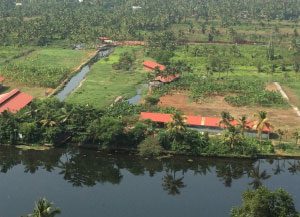A group of researchers from Amrita University conducted a research study for five years on the island near Amrita hospital, which was used as a landfill and dumpsite for several years, causing the soil to become completely contaminated with heavy metals from both the dumped waste and from the polluted Backwaters. The land was a dead zone with a striking absence of ants, insects, worms, and birds.

First removing the waste and then segregating it transformed this dumpsite. When the ground was cleared, a layer of thermal compost obtained from the first six months was spread on the contaminated soil. The size of the area covered in compost was approximately one acre and the compost was spread at a depth of 18 – 24 inches. Clean soil was then brought in and layered over the compost. After the cleanup phase, vermin-compost was added and planting began. Specific plants, such as vetiver grass (Chrysopogon zizanioides), were cultivated to induce phytoremediation of the soil.

Soon after applying the compost, the area, which had been bare of any vegetation, began attracting plant growth. By July 2011, almost one and a half years after the restoration efforts had started, the entire former dumpsite was covered by vegetation. Birds, insects, and other wildlife returned to the area. Gradually, the microbial life in the soil increased.
After the remediation activities had begun, every year’s soil samples indicated that heavy metal concentrations at the former dumpsite are reducing drastically. In January 2015, plant tissue samples only two metals were detectable (Copper and Lead), but within permissible limits.

This study concluded that it is possible to remediate the contaminated site with eco-friendly methods over a period of five years, to such an extent that it would be possible to grow healthy food on the site. It is possible to restore eco-system and the microbiology of the soil. The bioremediation methods consisted of a combination of phytoremediation, enhanced microbial activity, and vermicomposting.
| Metal | Restoration site soil mg/Kg | Plant tissue mg/Kg |
|---|---|---|
| Arsenic (As) | 2.48 | not detected |
| Cadmium (Cd) | 3.57 | not detected |
| Cobalt (Co) | 6.30 | not detected |
| Chromium (Cr) | 146.6 | not detected |
| Copper (Cu) | 126.0 | 1.45 |
| Mercury (Hg) | not detected | not detected |
| Nickel (Ni) | 26.44 | not detected |
| Led (Pb) | 112.5 | 0.05 |
Now, vegetables are being deliberately planted on the site to provide healthy food grown without chemicals for the hospital’s cancer patients.
The Amrita Hospital received a certificate of merit for substantial and sustained efforts in pollution control and for launching new initiatives for environment protection in 2014 by the Kerala State Pollution Control Board.
The information presented in this study is not only globally groundbreaking, but also essential if we are to restore polluted ecosystems and grow the healthy food that the world so desperately needs.

Current situation in India:
The contamination of water and soil with heavy metals through human activity is a growing concern, especially in lower-middle-income countries. Studies in India examining the heavy metal concentrations of surface water bodies in proximity to industrial areas show alarming and hazardous levels of heavy metals. Heavy metals have been associated with gastrointestinal disorders, diarrhea, stomatitis, tremor, hemoglobinuria causing a rust-red color to stool, ataxia, paralysis, vomiting and convulsion, depression, and pneumonia. Cultivation of crops for human and animal consumption on contaminated soil can potentially lead to the uptake and accumulation of heavy metals in the edible plant parts. Dietary intake of heavy metals through contaminated grains and vegetables poses a risk to human and animal health.

